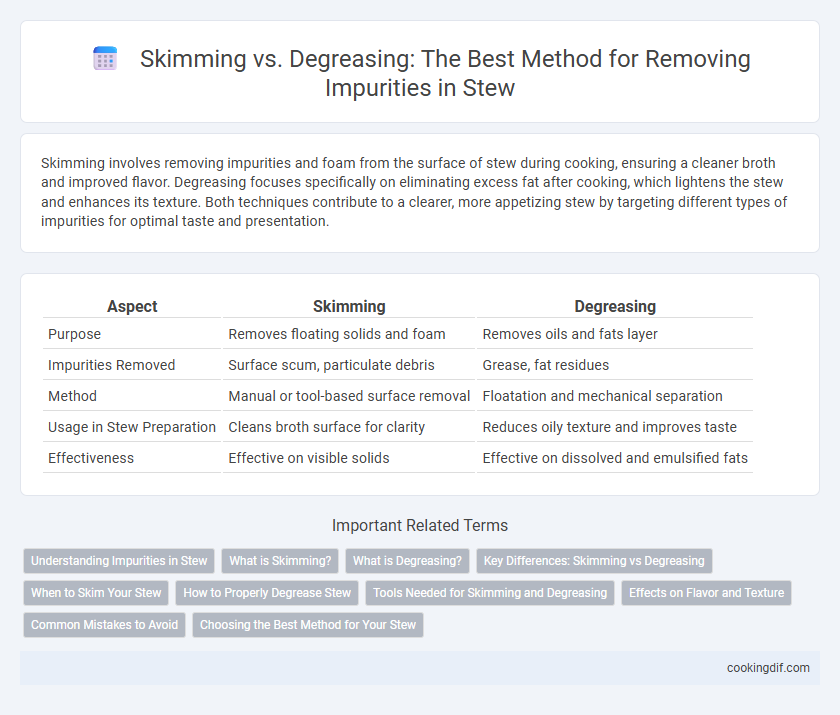Skimming involves removing impurities and foam from the surface of stew during cooking, ensuring a cleaner broth and improved flavor. Degreasing focuses specifically on eliminating excess fat after cooking, which lightens the stew and enhances its texture. Both techniques contribute to a clearer, more appetizing stew by targeting different types of impurities for optimal taste and presentation.
Table of Comparison
| Aspect | Skimming | Degreasing |
|---|---|---|
| Purpose | Removes floating solids and foam | Removes oils and fats layer |
| Impurities Removed | Surface scum, particulate debris | Grease, fat residues |
| Method | Manual or tool-based surface removal | Floatation and mechanical separation |
| Usage in Stew Preparation | Cleans broth surface for clarity | Reduces oily texture and improves taste |
| Effectiveness | Effective on visible solids | Effective on dissolved and emulsified fats |
Understanding Impurities in Stew
Skimming involves gently removing the surface fat and foam that rise during simmering, which helps eliminate impurities like coagulated proteins and airborne debris. Degreasing targets the removal of excess fat from the stew's surface after cooking, promoting a cleaner taste and improved texture. Understanding the types of impurities--protein scum versus lipid residues--is crucial for selecting the appropriate method to achieve a clear, flavorful stew.
What is Skimming?
Skimming is the process of removing impurities and excess fat that rise to the surface of a stew during cooking, using a spoon or skimmer. This technique helps achieve a clearer broth and improves the stew's overall flavor and appearance. By regularly skimming, cooks prevent unwanted residues from impacting the texture and taste of the dish.
What is Degreasing?
Degreasing in stew preparation refers to the process of removing excess fat from the surface of the liquid to create a cleaner, less greasy broth. Unlike skimming, which primarily removes impurities and foam, degreasing specifically targets the fat layer for a lighter texture and improved taste. Effective degreasing enhances the stew's flavor balance and reduces calorie content without losing essential nutrients.
Key Differences: Skimming vs Degreasing
Skimming involves removing the layer of fat and impurities that rise to the surface of a stew during cooking, typically with a spoon or ladle, preserving the stew's natural flavors and texture. Degreasing, on the other hand, is a more thorough process that extracts excess fat from the liquid, often by refrigeration and removing hardened fat or using specialized tools, resulting in a leaner broth with reduced greasiness. While skimming is a continuous, surface-level technique during cooking, degreasing is a post-cooking step aimed at improving clarity and mouthfeel.
When to Skim Your Stew
Skimming your stew is essential during the initial stages of simmering when impurities and foam rise to the surface, preventing cloudiness and improving flavor. Perform skimming within the first 15 to 30 minutes to remove proteins and scum before the stew thickens or develops. This technique contrasts with degreasing, which is applied later to reduce excess fat after cooking.
How to Properly Degrease Stew
Degreasing stew effectively involves chilling the cooked stew until fat solidifies on the surface, enabling easy removal with a spoon or a skimmer. Using a fat separator can streamline the process by pouring the liquid off beneath the grease layer, preserving flavor while eliminating excess oil. Proper degreasing enhances stew clarity and texture, reducing greasiness without compromising the rich taste.
Tools Needed for Skimming and Degreasing
Effective skimming requires a fine-mesh skimmer or a slotted spoon to gently remove foam and floating impurities from the surface of the stew. Degreasing tools often include a fat separator or a gravy lifter designed to pour off excess fat from the broth while retaining the flavorful liquid. Both methods enhance stew clarity and taste by targeting impurities but utilize distinct tools suited to their specific removal techniques.
Effects on Flavor and Texture
Skimming removes surface impurities and excess fat during cooking, preserving the stew's rich flavor while maintaining a balanced texture. Degreasing involves chilling the stew and removing solidified fat, resulting in a lighter mouthfeel and a clearer broth but potentially less depth in flavor. Choosing between skimming and degreasing depends on desired richness and texture preferences for the final dish.
Common Mistakes to Avoid
Skimming removes impurities like foam and scum from stew surfaces, but common mistakes include waiting too long to skim, which allows impurities to dissolve back into the liquid. Degreasing involves removing excess fat, often using a spoon or chilled fat layer, but failing to degrease properly can lead to greasy texture and overwhelming flavors. Avoid mixing these processes by skimming for impurities early in cooking and degreasing after cooling to maintain clarity and taste.
Choosing the Best Method for Your Stew
Skimming removes impurities and excess fat from the surface of stew by using a ladle or spoon, best for quick fat removal during simmering. Degreasing involves chilling the stew to solidify fat, allowing for easy removal and resulting in a cleaner, richer broth ideal for slow-cooked stews. Selecting the right method depends on cooking time, desired texture, and fat content, ensuring optimal flavor and presentation in your stew.
Skimming vs Degreasing for removing impurities Infographic

 cookingdif.com
cookingdif.com